Items
Site
The Medicine Chest
keywords is exactly
insider
-
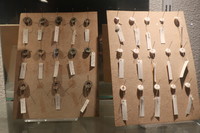
Buttons
A display of a collection of pins, buckles and buttons excavated from the washing pools used by slaves on Table Mountain. Taken from their dusty boxes in storage they are currently exhibited as part of Skotnes's 'Division of the World' (Department of Archaeology). -

Division of the World
"Undergraduate students regularly engage in discussions around certain displays as part of their teaching programme (N. Zachariou, personal communication, 27 May 2020), and the installation is also used to introduce visitors (exchange students and school children, for example) or students from other UCT departments (architecture students taking the archaeology module) to the department and the discipline (J. Parkington, personal communication, 20 June 2020). It has even been described as a ‘super curriculum’ (or as ‘several super curriculums’) for how it visualises what archaeology does on both an empirical and procedural level (J. Parkington, personal communication, 20 June 2020)" (Liebenberg 2021: 210). -
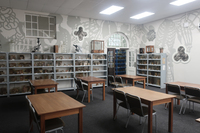
Subtle Thresholds (PLC)
"Integrated into the PLC, these works speak to the specimens on display and provide interesting access points to the collection. The animal-faeces prints (which referenced ‘sites of contamination’ in the context of the SAM exhibition) resonate, for instance, with many of the specimens on display in the PLC, such as the heterotopic heart (also called a ‘piggy-back heart transplant’) created by Dr Chris Barnard in 1977, consisting of a baboon heart grafted onto a human heart for additional motoric support. In addition to their more ‘famous’ specimens, the centre also has an extensive intestinal worm collection and many organs affected by zoonotic diseases, such as a liver ravaged by malaria. This was not a conscious decision on the part of the artist-curator and illustrates how curation can draw attention to aspects of a collection and liberate new associations when brought into conversation with it" (Liebenberg 2021: 201). -
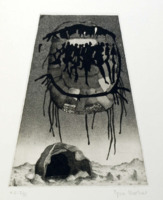
Etching from 'Sound from the Thinking Strings'
"Skotnes’s own visual interpretation of the history and cosmology of the |xam formed the last component of this interdisciplinary endeavour and constituted a visual component that drew together the various strands of disciplinary interpretations and presented a perspective on the |xam life she felt ‘was missing from the other interpretations’ (Skotnes 1991: 30). In these images she drew freely on San mythology, accounts of |xam life recorded by Lucy Lloyd, historical and archaeological research and images from rock paintings in a landscape setting. She writes in her preface that these etchings were direct attempts at ‘inverting the museum dioramas’ in the ethnographic halls close to the exhibition and which, through their display of the San’s body casts, rendered them closer to specimens of biology than as members of a highly developed culture (Skotnes 1991: 52). By creating images that combined shamanistic rituals, entoptic spirals, plants, hunting bags, bows and arrows, snakes, eland-shaped rainclouds, colonists, musical instruments, shelters and therianthropic shapes, Skotnes eclipsed the static narratives of the dioramas and the object labels in the exhibition, placing them in a context in which their metaphysical qualities were celebrated more than their physical qualities. These prints stood in striking contrast to the other exhibits, which framed the San as physical types, and they challenged viewers to confront the reality that the San had a rich history and cultural and social life" (Liebenberg 2021: 157). -
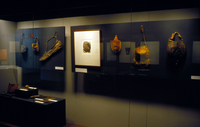
Sound from the Thinking Strings (installation detail)
"Skotnes had a longstanding relationship with the museum, which started when she was still a student at the Michaelis School of Fine Art. Davison remembers that Skotnes would visit the taxidermy section of the South African museum to draw bones. As an anthropologist, Davison admits to finding Skotnes’s way of looking at things stimulating – an individual way of looking at objects that made her look at them differently, even though she was already very familiar with these materials. Davison recalls a visit to the ethnographic stores during which she showed Skotnes the San skin bags, carefully conserved in their drawers and laid out on acid-free paper. Skotnes admired not only their aesthetic qualities but related the stories she had been studying in the Bleek and Lloyd archive to them – stories that shifted their status from anthropological museum objects to powerful animate objects in San spiritual and social life (P. Davison, personal communication, 28 January 2021). Skotnes remembers that she asked staff whether they knew what was inside the bags and was shocked when nobody could remember looking in them. She was allowed to look inside one and found a claw, which they thought must be a leopard’s (P. Skotnes, personal communication, 9 May 2021)" (Liebenberg 2021: 2015). -
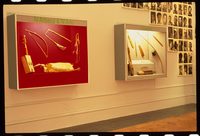
Miscast (installation detail)
Instruments from the Kirby collection displayed as part of the 'Miscast' exhibition. -
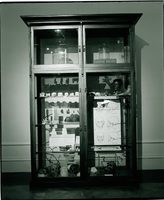
Miscast (installation detail)
"In juxtaposing instruments that are still being used (such as the scalpel and the camera) with ones that are not (the Von Luschan skin colour chart and the anthropometric measuring rods), Skotnes set up an opportunity for science to reflect on its past and on the activities and objects of its present, enabling a mode of self-reflexivity that is not a standard part of its day-to-day practices. Through curatorship, she exposed disciplinary practitioners to naturalisations and blind spots within their fields and sensitised them to these previously occluded characteristics" (Liebenberg 2021: 172). -
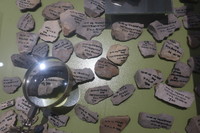
Stone tools
"By positioning artefacts to emphasise their labelling (stones are positioned to reveal the details written on them), including seemingly familiar objects and expanding and shrinking timelines, the installation [Division of the World] draws attention to the framing devices, tools and methods of the department’s insiders" (Liebenberg 2021: 207). -
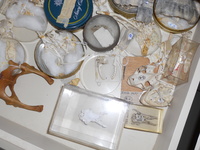
Things zoological insiders look at
A sample box of archaeological specimens shown to first year students. -
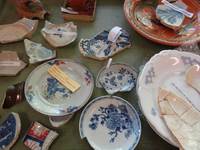
Things archaeological insiders look at
A variety of pottery shards of Asian porcelain, European earthenware and British stoneware in a drawer in the Department of Archaeology, UCT. -
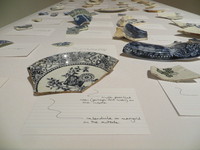
Appendix (installation shot)
A variety of pottery shards consisting of Asian porcelain, European earthenware and British stoneware sourced from the University of Cape Town Archaeology department and subjected to a botanical analysis by a graduate of the Biological Science (Botany) Department. -

Miscast (instruments of measurement)
"Along with the guides that regulated practices and protocols to stabilise and standardise an individual’s response to unfamiliar and disorienting sights (Kennedy 2013: 42), the gender, class and ethnicity of the observer were also of importance , as was the use of ‘ever more sophisticated instruments and calculations designed to minimize the intrusion of subjectivity into the reporting of information’ (Driver 2001: 55). By regulating who was doing the viewing, stipulating what should be viewed and how and supplying tools to measure these observations, scientific institutions promoted an authoritative ‘way of seeing’ in the field that differentiated the scientific view from that of the ordinary traveller (Driver 2001: 49)" (Liebenberg 2021: 109). -

Kuhn's Jellyfish
Kuhn's "example illustrates how the entrenched expectations of experimental outcomes and prescribed instrumental functions of an insider’s view of the laboratory and its equipment can pose a threat to new discoveries. The circumstances that enabled Roentgen (an insider) to first notice these new rays are not clear, but Kuhn proposes that the occurrence of anomaly enables discovery and that Roentgen’s ‘recognition that nature has somehow violated the paradigm-induced expectations that govern normal science’ (1970: 52–3) was important. Kuhn emphasises that Roentgen valued the anomaly instead of ignoring it – a vital step in the process of discovery" (Liebenberg 2021: 114). -

Breath of a Physicist
William Blake, 1794, Ancient of Days Inscription: "In his hand, he took the Golden Compasses, prepared in Gods Eternal stone, to circumscribe This Universe, and all created things One foot he center'd, and the other turn'd Round through the vast profundity obscure, And said, thus farr extend, thus far thy bounds, This be thy just circumference, O World" "In the process of realising this work, [Cornelia] Parker facilitated the collaboration of scientists from the physics department with those from its art gallery. She also drew attention to the scientific qualities of the artwork and, through the performative act of igniting a firework display, the symbolism of scientific discovery" (Liebenberg 2021: 31). -
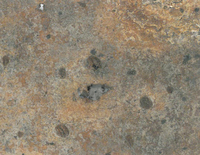
Skin
I collected leaves from the gardens around Groote Schuur Hospital and gave them to UCT dermatologist Ranks Lehloenya for analysis. Using the strategy of directing insider focus to an outsider object, Lehloenya treated these specimens as sections of skin and read them accordingly, highlighting sections that showed signs of nummular eczema, acne, ageing, miliary tuberculosis and melanoma, to name a few (Liebenberg 2021: 277). This example was diagnosed as follows: "This section shows characteristics which could point at various causes. The darker raised sections could be blackheads as seen in acne (note the darker central area reminiscent of an open pore); villous hair cysts ( a condition in which hair follicles are trapped under the skin to form pimple-like structures with the hair giving a dark hue in the centre; syringomas (non-cancerous proliferation of sweat glands); infections such as chicken pox or miliary tuberculosis in which the infection spreads from the blood onto the skin (miliary mean it looks like a millet seed). It could also be metastatic melanoma that has spread from another area onto this skin". -
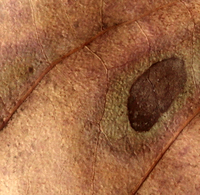
Skin
I collected leaves from the gardens around Groote Schuur Hospital and gave them to UCT dermatologist Ranks Lehloenya for analysis. Using the strategy of directing insider focus to an outsider object, Lehloenya treated these specimens as sections of skin and read them accordingly, highlighting sections that showed signs of nummular eczema, acne, ageing, miliary tuberculosis and melanoma, to name a few (Liebenberg 2021: 277). This example exhibits an annular pattern which could be an infection like a ringworm (fungus) and erythema migrans of Lyme’s disease; or inflammatory conditions like nummular eczema, erythema marginatum as seen in rheumatic fever and granuloma annulare.


